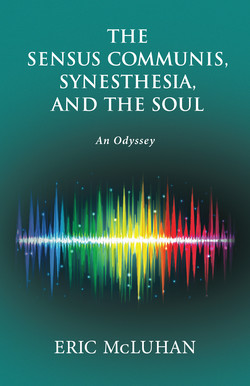Читать книгу The Sensus Communis, Synesthesia, and the Soul - Eric McLuhan - Страница 7
Оглавление
Foreword Is Forewarned
When I came across a description of the experience of mysticism in Henri de Lubac’s magisterial Medieval Exegesis: The Four Senses of Scripture, I found myself on familiar ground. It brought forcefully to mind the experience of mimesis in ancient Greek poetics.
Mimesis is the technique of interiorization: knowing by putting-on, knowing by becoming, intellectually and emotionally, the thing known. That is, integral, interiorized knowing instead of conceptual knowing: unmediated, direct perception by the body and the emotions and the intellect of the hearer, that is, by the hearer’s soul. Direct experience by total submergence. (p. 22, infra.)
Fifty years ago, Eric Havelock wrote in Preface to Plato about Plato’s “war” with the bards over their use of mimesis.Their approach engendered the total, the almost pathological involvement of the hearer in the poetic performance, an involvement so profound that the hearer effectively became the poem. He put on the characters; he spoke their words; he performed their actions; he suffered, triumphed, exulted, despaired as they did, and he did this so completely that a single exposure fixed the recitation perfectly in his memory for the rest of his life.
Thirty years later you could automatically quote what Achilles had said or what the poet had said about him. Such enormous powers of poetic memorization could be purchased only at the cost of total loss of objectivity...This then is the master clue to Plato’s choice of the word mimesis to describe the poetic experience. It focuses initially not on the artist’s creative act but on his power to make his audience identify almost pathologically and certainly sympathetically with the content of what he is saying...(p. 23, infra)
Plato was determined to break the spell and inculcate instead the exotic new skills of abstract thought and objectivity that accompanied the alphabet. Abstraction was essential to the new science of philosophy, so Plato waged the first media war. Aristotle continued the campaign with an immensely powerful technology of his own devising: the syllogism.
Fifteen hundred years after Plato and Aristotle, as de Lubac reveals, mimesis can again be found at work, albeit in a totally separate context, that of the interpretation of Scripture. More particularly, interpretation at the level of mysticism, the “anagogical” level. Unlike the historical, allegorical, and tropologiical senses of Scripture, the anagogical sense does not consist of ideas: it is constituted as direct experience, one generally regarded as ineffable and beyond words or explanation. The reader puts on, or enters into, the passage of Scripture so completely as to become it. He transcends mere intellectual understanding and attains, through contemplation, a state of knowing through his whole being.
Perhaps equally surprising, mimesis is everywhere in evidence in our contemporary world, particularly in the arts and in advertising, and in modern media. This reversal has implications for the Church and the sacraments, implications that need to be addressed without delay.
Accordingly, this essay concerns both experience and the several kinds of sense: intellectual, corporeal, and spiritual. As far as possible I have tried to avoid theory and stick to a common sense approach. Moreover, the ancient and medieval doctrine of common sense, the human sensus communis, is particularly relevant to contemporary experience. It is evident, for example, in the condition psychologists call synesthesia, which also has much to tell us about mimesis.
These pages, then, treat of: the four senses of exegesis mentioned above (particularly anagogy); the bodily senses; and mimesis as experiences and as modes of insight, not in terms of ideas or theories. Experiences can be checked, shared, verified by anyone. These considerations naturally bring into the discussion the notion of the Common Sense, which today plays such a central part in the study of communication and the associated technologies. In turn, the sensus communis, an obscure artifact of Aristotelian philosophy and medieval theology, has quietly invaded the unsuspecting contemporary world disguised as synesthesia. The poets, and the blind, have much to offer us on its account, so they contribute a few insights to our discussion. The senses we discuss are multifarious: there are the five bodily senses, and the intellectual senses of Scripture that de Lubac discusses, as well as the theological senses (the theological virtues of faith, hope, charity). Meanwhile, each group, we discover, has its own sensus communis, and the three groups are in communion with one another.
Modern media exert a profound, destabilizing effect on the sensus communis and on the interrelation of the various senses; consequently, we turn in these pages to a consideration of the importance and significance of the body. The meaning of the human body cannot be overstated, as John Paul II shows in depth in his seminal Man and Woman He Created them: A Theology of the Body: the body is everywhere assaulted by all of our new media, a state that has resulted in deep disorientation of intellect and destabilization of culture throughout the world. In the age of disembodied communication, the meaning, significance, and experience of the body are utterly transformed and distorted.
Before we can take steps to counteract the influence of our technologies on our senses, we must investigate how they bring their influence to bear and what can be done about that. On the one hand, the arts may hold a significant part of the answer; on the other, an increased emphasis on participation in the sacraments would go a long way toward rectifying matters.
It is time to bring forward a Catholic theory of communication1 that takes into account the transformation of the users of media.
Eric McLuhan Bloomfield, Ontario, 2013-2015
